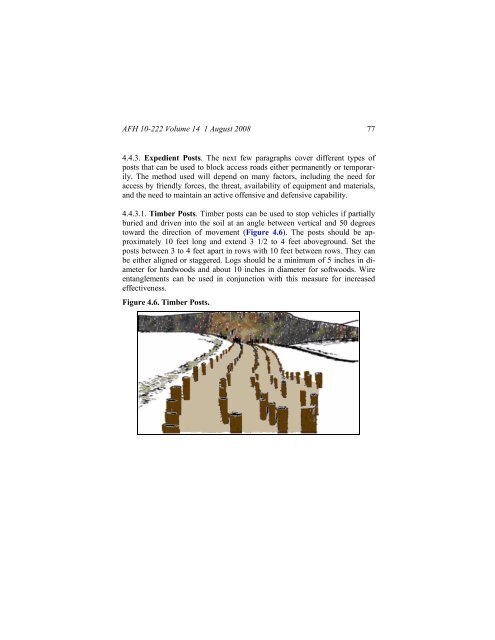Civil engineer guide to fighting positions, shelters, obstacles
Civil engineer guide to fighting positions, shelters, obstacles
Civil engineer guide to fighting positions, shelters, obstacles
You also want an ePaper? Increase the reach of your titles
YUMPU automatically turns print PDFs into web optimized ePapers that Google loves.
AFH 10-222 Volume 14 1 August 2008 77<br />
4.4.3. Expedient Posts. The next few paragraphs cover different types of<br />
posts that can be used <strong>to</strong> block access roads either permanently or temporarily.<br />
The method used will depend on many fac<strong>to</strong>rs, including the need for<br />
access by friendly forces, the threat, availability of equipment and materials,<br />
and the need <strong>to</strong> maintain an active offensive and defensive capability.<br />
4.4.3.1. Timber Posts. Timber posts can be used <strong>to</strong> s<strong>to</strong>p vehicles if partially<br />
buried and driven in<strong>to</strong> the soil at an angle between vertical and 50 degrees<br />
<strong>to</strong>ward the direction of movement (Figure 4.6). The posts should be approximately<br />
10 feet long and extend 3 1/2 <strong>to</strong> 4 feet aboveground. Set the<br />
posts between 3 <strong>to</strong> 4 feet apart in rows with 10 feet between rows. They can<br />
be either aligned or staggered. Logs should be a minimum of 5 inches in diameter<br />
for hardwoods and about 10 inches in diameter for softwoods. Wire<br />
entanglements can be used in conjunction with this measure for increased<br />
effectiveness.<br />
Figure 4.6. Timber Posts.
















